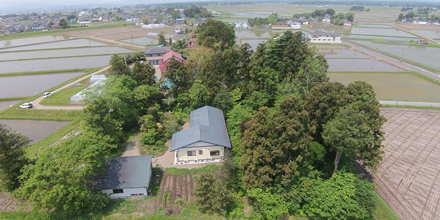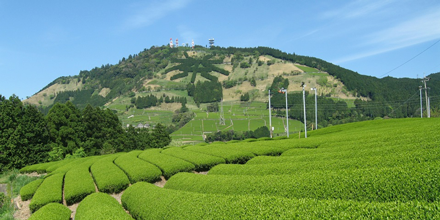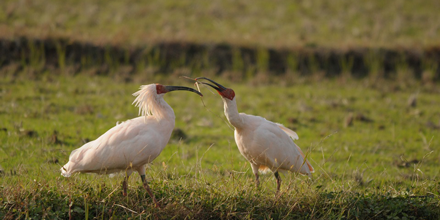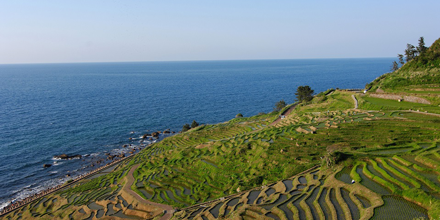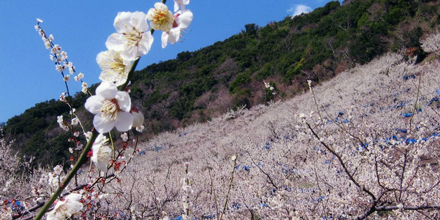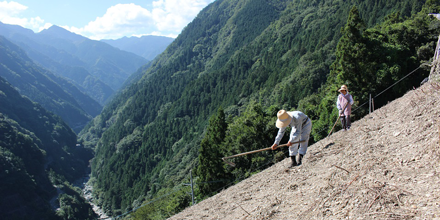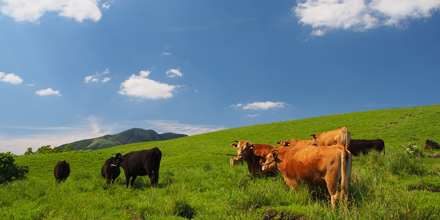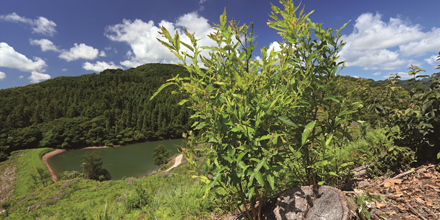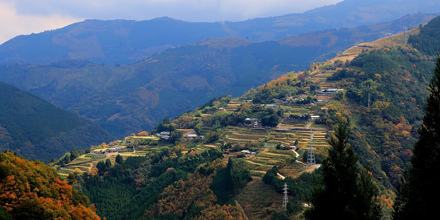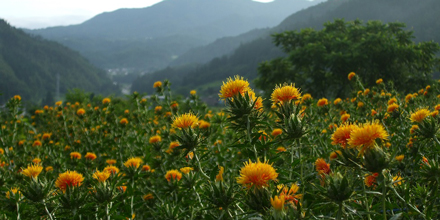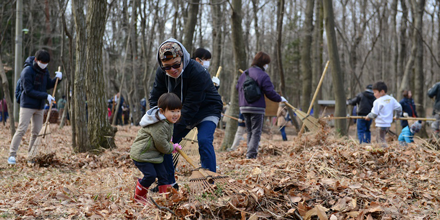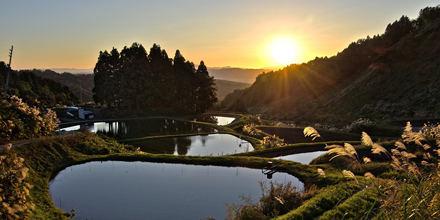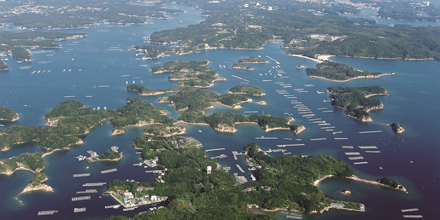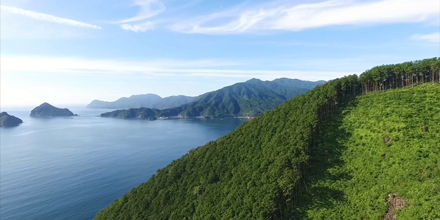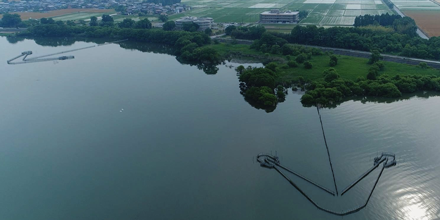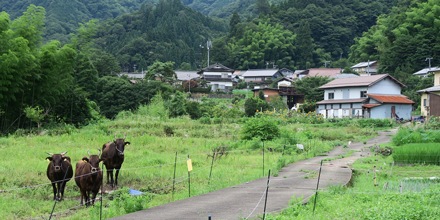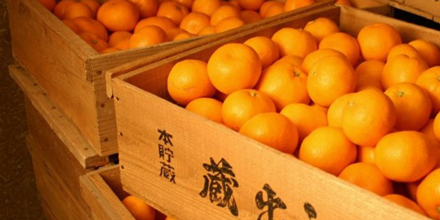What Are GIAHS & J-NIAHS?
Heritage Systems (J-NIAHS) are initiatives that set the basis for recognition of important agricultural, forestry, and fishery systems that ought to be passed on to future generations. Within these systems, unique traditional industries, which have evolved with their communities and environments over generations, are interrelated and integrated with the cultures, landscapes* and/or seascapes**, and agricultural biodiversity*** that have developed in close relation with them.
- ※1 Landscape: A cohesive regional entity whose character is the result of agricultural, forestry, and fishery activities conducted on the land
- ※2 Seascape: An entity whose character is the result of activities such as fishing and aquaculture conducted in coastal waters
- ※3 Agricultural biodiversity: A state of abundance of biodiversity and genetic resources related to food and agriculture
What Is GIAHS?
The Globally Important Agricultural Heritage Systems (GIAHS) is an initiative through which the Food and Agriculture Organization of the United Nations (FAO) recognizes globally important sites where traditional agriculture, forestry, and fishery activities are conducted (agriculture, forestry, and fishery systems).
In 2002, the FAO launched an initiative to support the conservation and adaptive management of the GIAHS sites. The initiative aims to lay the foundations for global recognition, dynamic conservation, and adaptive management of GIAHS sites, and for protecting and supporting agricultural biodiversity, knowledge systems, food and livelihood security, and culture throughout the world.
The goal of GIAHS is to maintain and preserve traditional agricultural methods that leverage their natural environments, land use that sustains biodiversity, and rural cultures and landscapes, which are in danger of being lost due to modernization, as integrated “regional systems” to be passed on to future generations.
There are currently 62 GIAHS sites in 22 countries around the world, including 11 in Japan (as of November 2021).
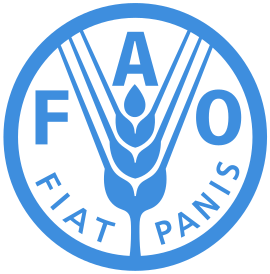
GIAHS Selection Criteria
Food and livelihood security
The proposed agriculture, forestry, and/or fishery system must contribute to the incomes of people in local communities and to the local economy.
Agricultural biodiversity
The proposed agriculture, forestry, and/or fishery system must be endowed with globally significant biodiversity and genetic resources for food and agriculture.
Local traditional knowledge systems
The system must maintain “local and invaluable traditional knowledge and practices,” “ingenious adaptive technology,” and “management systems of natural resources, including biota, land, and water which have supported agricultural, forestry and/or fishery activities.”
Cultures, value systems, and social organizations
The cultural identity and sense of place related to the proposed agriculture, forestry, and/or fishery system must be embedded in and belong to the proposed agricultural site.
Landscape and seascape features
The system must have landscapes and/or seascapes that have been developed over time through interaction between humans and the environment.
Designated GIAHS Sites
Tohoku
Osaki Kodo’s Traditional Water Management System for Sustainable Paddy Agriculture
(Osaki region, Miyagi Prefecture; GIAHS since 2017)Kanto
Traditional Tea-grass Integrated System in Shizuoka(Kakegawa and surrounding region, Shizuoka Prefecture; GIAHS since 2013)
Traditional Wasabi Cultivation in Shizuoka(Wasabi cultivation region, Shizuoka Prefecture; GIAHS since 2018)Hokuriku
Sado’s Satoyama in Harmony with Japanese Crested Ibis(Sado City, Niigata Prefecture; GIAHS since 2011)
Noto’s Satoyama and Satoumi(Noto region, Ishikawa Prefecture; GIAHS since 2011)Tokai
Ayu of the Nagara River System – The Connection Between Ayu and the People of the Satokawa(Upper and middle courses of the Nagara River, Gifu Prefecture; GIAHS since 2015)Kinki
Minabe-Tanabe Ume System(Minabe-Tanabe region, Wakayama Prefecture; GIAHS since 2015)Chugoku/Shikoku
Nishi-Awa Steep Slope Land Agriculture System(Nishi-Awa area, Tokushima Prefecture; GIAHS since 2018)Kyushu
Managing Aso Grasslands for Sustainable Agriculture(Aso region, Kumamoto Prefecture; GIAHS since 2013)
Kunisaki Peninsula Usa Integrated Forestry, Agriculture and Fisheries Systems(Kunisaki Peninsula Usa area, Oita Prefecture; GIAHS 2013)
Takachihogo-Shiibayama Mountainous Agriculture and Forestry System(Takachihogo-Shiibayama area, Miyazaki Prefecture; GIAHS since 2015)
What Is J-NIAHS?
The Japanese Nationally Important Agricultural Heritage Systems (J-NIAHS) is an initiative through which the Minister of Agriculture, Forestry and Fisheries recognizes regions in Japan where important and traditional agriculture, forestry, and fishery activities are conducted (agriculture, forestry, and fishery systems).
Eight sites, including the Kyoto region, were first designated as J-NIAHS in March 2017.
In addition to the five GIAHS criteria, J-NIAHS has three selection criteria of its own:
- 6. Resilience to change
In Japan, where natural disasters occur frequently, many agriculture, forestry, and fishery systems have withstood natural disasters and adapted to changes over a long period of history. The site must maintain a high level of resilience to disasters and other unforeseen circumstances, in order to preserve the agriculture, forestry, and/or fishery system and ensure its transmission to future generations. - 7.Participation of various entities
Facing a fall in the number of farm successors and other social changes, to maintain and revitalize traditional agriculture, forestry, and fishery industries and the cultural and ecological conservation systems with which they are connected, the system must be being carried forward through new mechanisms in which not only of local residents but diverse entities are involved. - 8.Promotion of “sixth-order” industries
The site must utilize aspects of the system such as its historical value; agricultural, forestry, and/or fishery products; traditional culture; and landscapes to vitalize the region and preserve its system through the promotion of “sixth-order” industries, etc. on an areawide basis, including agricultural product branding and tourism promotion.
There are currently 22 designated J-NIAHS sites in 16 prefectures (as of March 2021).
J-NIAHS Sites
Tohoku
Osaki Kodo’s Traditional Water Management System for Sustainable Paddy Agriculture
(Osaki region, Miyagi Prefecture; J-NIAHS since 2016)
Yamagata’s “Best Safflower” Connecting History and Tradition – The Only Japanese Processing system for Safflower Production and Dyeing Which Is Rare in the World
(Mogami River basin, Yamagata Prefecture; J-NIAHS since 2018)Kanto
Musashino’s Fallen Leaves Compost Farming Method
(Musashino region, Saitama Prefecture; J-NIAHS since 2016)
Traditional Wasabi Cultivation in Shizuoka
(Wasabi cultivation region, Shizuoka Prefecture; J-NIAHS since 2016)Hokuriku
Rice Farming and Carp Breeding System Utilizing the Blessings of Snow
(Chuetsu region, Niigata Prefecture; J-NIAHS since 2016)
Brackish Water Lake Fishery System of the Mikata Five Lakes
(Mikata Goko region, Fukui Prefecture; J-NIAHS since 2018)Tokai
Toba-Shima Ama Fishery and Pearl Culture
System
(Toba-Shima region, Mie Prefecture; J-NIAHS since 2016)
Owase Cypress Forestry Created by Steep Terrain and One of the Highest Rainfall Levels in Japan
(Kihoku, Owase City, Mie Prefecture; J-NIAHS since 2016)Kinki
Lake Biwa System of Interwoven Fishing and Agriculture Developed in Forests, Villages, and the Lake
(Lake Biwa region, Shiga Prefecture; J-NIAHS since 2018)
Hyogo-Mikata’s Tajima Cattle System
(Hyogo-Mikata region, Hyogo Prefecture; J-NIAHS since 2018)
Shimotsu Storehouse-Ripened Mandarin System
(Shimotsu region, Kainan City, Wakayama Prefecture; J-NIAHS since 2018)Chugoku/Shikoku
Nishi-Awa Steep Slope Land Agriculture
System
(Nishi-Awa region, Tokushima Prefecture; J-NIAHS since 2016)
Resource Circulation Agriculture of Okuizumo Derived from Tatara Ironmaking
(Okuizumo region, Shimane Prefecture; J-NIAHS since 2018)
Citrus Farming System of Nanyo, Ehime
(Nanyo region, Ehime Prefecture; J-NIAHS since 2018)

